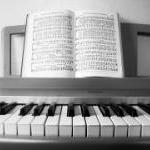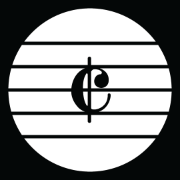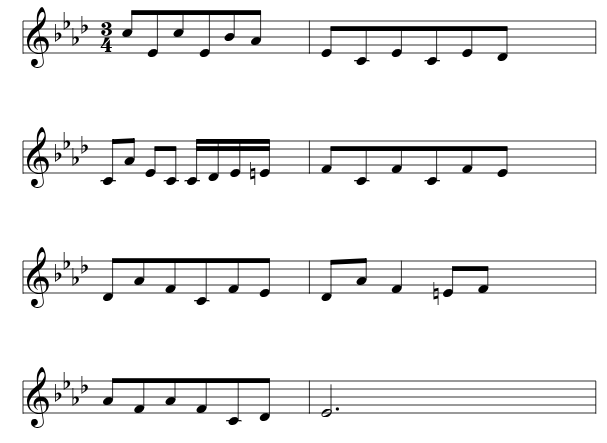All Activity
- Today
-
Churchcantor started following Piano sonata no 1 in B flat major ( Mozartian style )
-
I would be especially delighted if you could also listen to my other pieces on my channel, particularly the sonatas in binary form. In these sonatas, I drew immense inspiration from Scarlatti, but I also combine all the influences and impressions I have from my favorite composers, mainly Mozart and Schubert. So, it is a blend of Scarlatti, Mozart, and Schubert, and I can say that the result is quite impressive. I look forward to hearing your opinion .
-
Thank you very much, my dear friend, for your attention and appreciation of my sonata. This sonata holds a special place in my heart because I had to honor my beloved composer, which is very difficult since Mozart is unique. I worked hard to achieve this result. Once again, thank you. As for the performance, yes, I play all of my compositions myself. I record through GarageBand, and I have purchased Pianoteq 8, which I use as a plug-in for my recordings.
-
This piece was wonderfully written — for a moment, I thought Mozart composed it. Impressive work! You clearly understood the structure of the sonata, and I enjoyed every note of it. Did you perform this piece yourself? I always admire fellow composers here who have written sonatas, because I have not yet acquired the capacity to achieve that.
-
Henry Ng Tsz Kiu started following Miniature concerto for bassoon
-
Alex Weidmann started following Miniature concerto for bassoon
-
Hi to all. I've recently been asked to write a 5 minute piece for chamber orchestra, prominently featuring the bassoon. A sort of mini bassoon concerto if you will, for a concert next summer. Here's what I have so far. Only started writing it two days ago: so it's not remotely finished, and I haven't put in slurs or articulation yet. Some of the dynamics are just for the midi playback. Wanted to ask my fellow composers if you think it's any good? And where it needs improvements? As usual I wrote it mostly by instinct, and didn't really think much about voice leading, or harmonic progressions. As some of you know, I quite like sparse textures; but I wonder if it's a little too sparse? Also whether it features the bassoon prominently enough to hit the brief? A critique of my harmonic progressions and orchestration would be very helpful. Also I don't have a name for it yet: so any suggestions welcome!
-
Hey Peter, I like the peaceful mood you portrayed and the microtone really fits the underworld setting. I love the sound of the col legno here, they sound like the ants or underground monsters, but I am not sure it will sound like this when played in real life! Love the alto flute as well! Thx for sharing! Henry
-
Henry Ng Tsz Kiu started following Sing It Loud arranged for SATB
- Yesterday
-
PeterthePapercomPoser started following Variations on a Wanderer's Theme
-
Churchcantor started following Missa Sancti Martini - Kyrie
-
Definitely go on with the mass! I'm not even Roman Catholic, and I wrote two! A regular one and a Requiem. Can't resist cracking a joke; Missa Sancti Martini? Shaken, not stirred!😆 Upon actually listening, I would say develop this material, which is pretty good, and make it longer! Now, you might get some length from the Credo, Nicene Creed, which unlike the Kyrie is a real tome.
-
Underwater Cave - Microtonal VGM
chopin replied to PeterthePapercomPoser's topic in Incidental Music and Soundtracks
Ah nice catch. That one brings back memories! -
PeterthePapercomPoser started following Sing It Loud arranged for SATB
-
Hi all, This is the arrangement of my children's song Sing It Loud for SATB (previously posted). I usually do not compose choral works (Although - I have a few) so all comments/feedback especially the engraving is appreciated. So all you choir people - let me know what you think. Mark
-
- 1
-

-
chopin started following Underwater Cave - Microtonal VGM
-
Underwater Cave - Microtonal VGM
chopin replied to PeterthePapercomPoser's topic in Incidental Music and Soundtracks
Certainly a very water-like feel to this. Almost hypnotizing! I definitely am getting a very claustrophobic vibe. But in a way, this sorta reminds me of Mario 64's water theme. The moods are completely different, but textures are similar. Your music is much more complex especially with the microtones, and more focused on atmosphere, whereas Nintendo's version focuses on melody. But both pieces of music achieve their intended effects! -
Henry Ng Tsz Kiu started following Underwater Cave - Microtonal VGM
-
PeterthePapercomPoser started following Underwater Cave - Microtonal VGM
-
I have borrowed a motif from my Ice Cave VGM track that I published not long ago. This time I applied a microtonal inflection to the motif (in 24 TET). The environment would require the player to go cave-diving during this music. I tried to make the piece sound watery through the use of Alto Flute and a low Vibraphone (played by Lumatone) ostinato. The idea that prompted the creation of this track was to layer on top of each other heterophonically or polyphonically different microtonal variations of the same motif. Let me know what you think and whether I've succeeded! I welcome any of your comments, suggestions, critiques, or just observations. Thanks for listening!
- Last week
-
Idea for a piano duet. Maybe it’s better off being a synth based work but I came up with it playing the piano. It's a short idea but any impressions and feedback is appreciated. Its performed with a midi keyboard
-

Oboe Concerto
GospelPiano12 replied to GospelPiano12's topic in Incomplete Works; Writer's Block and Suggestions
I like this idea! I will definitely start exploring these variations you've mentioned. I think this would be great!! Especially as I start thinking about instrumentation and voicing and color. Of course, your suggestions are always welcome. Thank you. Seems like I have a lot of work on my hands lol -
.thumb.png.8b5b433a341551e913a34392660bc95b.png)
Oboe Concerto
PeterthePapercomPoser replied to GospelPiano12's topic in Incomplete Works; Writer's Block and Suggestions
Hey @GospelPiano12! I think starting out with a really simple phrase like this is a great way to start! In my own experience, I've always relied on being able to come up with variations of the main melodic idea that my piece is based on, and in the case of a concerto type of piece, virtuosic variations. Even if your ultimate form isn't going to be a theme and variations, being able to pre-compose various different versions of your main theme will get you far in terms of giving you the ideas you need to put the piece together. So, what you have here is a really great simple idea that you can easily subject to virtuosic variations by inserting notes in between the melody notes you already have: This could also potentially lead to the formation of ostinati or repeating accompanimental figures which can give your piece some rhythmic drive! Also, since you're writing a concerto for a wind instrument, it's important to remember to give your soloist choice places to breathe. Most of my own concerto type works have been for piano and orchestra. I've written things for Violin and Piano or Violin and Harpsichord, but they were short (and the former, microtonal). I think you can, if you want, use this thread as a place to bounce your ideas off of the community as you make progress. If you're comfortable I can make suggestions like this periodically. I always have more ideas for more variations! Like they said in the movie "Blazing Saddles" - "My mind is a .. a raging torrent! Flooded with rivulets of thought .. cascading into a waterfall of creative alternatives!" LoL -
Good Evening All, I've set out to write an oboe concerto, but I wrote this fragment and realized that I don't know how to write a concerto...any advice/tips? Also, please don't come at me for the notation...it's giving 6/4, but I'm just in the beginning stages of brain storming Oboe sketches.mp3
-
Many thanks for your input! I feel your enthusiasm for these types of posts. They are, after all, a kind of public challenge for which we can showcase our knowledge while also collaborating with others. I would personally like to get more involved with such things. It would be awesome if we maintained, as a group, a repository for knowledge in the art of composition - for example how to consider voice leading against chromaticism. No doubt we would need distinct zones for functional harmony and otherwise to accommodate people's diverse ascetic interests on this forum. That aside, I had seen E as a common tone opportunity for a pedal, potentially, but that seemed a little boring and unadventurous. However, as you suggest, perhaps it is neither necessary to add further complexity if the outer voices are already doing something interesting and distinct. Nonetheless, I thought I would rise to the challenge. I like your solution - that largely moves in thirds with the base and for which there are opportunities for further refinement by recycling some motifs from elsewhere in the piece. I am unsure about the treatment of the third bar as E7, considering the bass resolves to A minor, although the only note that may undermine this is the D in the clarinet during the third beat of that bar. You're right about the b natural in the bassoon - that was an oversight on my part. I will have a tinker over the coming days and report back here with what I've come up with.
-
honestly probably the best song I've ever made. Basic, but good.
- 1 reply
-
- piano
- incidental
-
(and 2 more)
Tagged with:
-
TristanTheTristan joined the community
-
I think I broke it.
-
Three Part Songs to Poems by G.M. Hopkins Free Sheet Music by Robert C. Fox for Various Instruments | Noteflight I'll get the other two in! Here's a start. The Windhover.
-
This is actually a personal narrative. I generated the character names as pseudonyms for privacy reasons (so I don’t get yelled by the actual people.) This is all written in the perspective of Ross (the pseudonym for me). As you could see, this is a part three out of four parts and I have the fourth act already written. I just have to edit it and add the names. Feel free to check out the first and 2nd movement. It has some musical context along with the storyline. But thank you for listening to it. I always wanted an analysis or at least feedback of the piece. So definitely thank you
-
Hey Markus, I haven't seen you in a while, glad to hear you're still writing 🙂 I love these kinds of posts. It's really cool to hear your problem, then for me to try it out and mess around on it. Thanks for posting your thought process, as I can start with yours and see where that takes me. One idea I had was to let the clarinet be a pedal point for the E7. I had F for the "Dm" chord measure, but it didn't sound good to me. I liked the absence of the clarinet here, so maybe keep it simple if this thought leads you somewhere. For me, it helps to see the entire 4 bar phrase as E7. I know that one spot is tricky, but it just seems like a big cadence to Am (Also, this whole transition from Bb to F is wonderful and very smooth. Is it Am - C7 - F? I like the iii - V7 - I movement). If I look at it as E7 with a bunch of chromatics, it's easier to think about the clarinet. I came up with this pretty quick, I'm sure the notes could be tinkered with. I don't remember, but little rhythmic motifs you may have used could go well with the clarinet, I just came up with something simple. Oh, and our music player sucks lol. It's hard to go to a certain spot within a piece, so I think I've heard the first minute or so several times 😄 Hopefully some of these thoughts are useful 🙂 Great stuff, keep us updated! P.S. The bassoon starts on B nat. right?







.thumb.png.f5c7c1a6a554eeeefdce321d089f5901.png)

